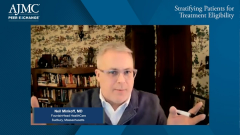
Offsetting the Increased Cost of AD Treatment
Key opinion leaders discuss possible ways to mitigate the increased cost of Alzheimer disease treatment.
Episodes in this series

Neil Minkoff, MD: As we start thinking about it from a societal as well as a health care point of view, one of the things that comes to mind that we have already touched on a bit is that it is expensive now, but it could be more expensive later. Mike, you talked about a number of the possibilities in terms of the work-up and the things that would be necessary or at least helpful in terms of benefits and policies. What case would you try to make around cost offsets in the future?
Michael Cantor, MD: It goes back to understanding how that coverage decision is made. The coverage decision is made when there is a clear cost benefit to providing that therapy. That begins with good research, understanding whether the drug accomplishes what the manufacturer says it is going to accomplish in terms of modifying the therapy to deliver on the benefits for that person’s symptoms, whether it is disease modification, or reducing the progression of the disease. Someday, even better would be curative therapies that would be able to undo the damage that, in many cases, has already been done by the time we figure out that the person has Alzheimer disease or related dementia.
Assuming that the data are there and that we can show that it is effective from a physiological perspective and whatever the outcomes are that we agree to measure, the cost avoidance will come from a couple of different areas. Certainly, people who have cognitive impairment tend to have a lot more complications when they get treated, so they become delirious more often, they spend more time in the hospital, they end up going to skilled nursing facilities on the way home instead of going straight home, and they use home care more often. Their care is always more complicated, so there would probably be some reduction in their medical costs as it relates to acute illness, hospitalizations, and so on.
On the long-term care side, when we talk about Medicaid, there may potentially be even greater savings in terms of keeping people at home and letting them use fewer home services to stay healthy because they will not have the cognitive impairment piece. One of the problems with people with cognitive impairment is that their illness is unpredictable. When will someone wander outside? When will someone become delusional and begin to see things that are not there? Sundowning is the term that people use for what happens late in the afternoon or early evening when people begin to get more confused. We do not understand why this happens to some people and not others. If we can avoid those kinds of symptoms and the kind of behavior that happens at very unusual hours—people are up at night instead of sleeping and sleeping during the day instead of staying up—then there will be massive impact on long-term care costs for our society.
Then there are the health care costs that come from caregivers who are stressed out and burdened. There is a lot of research showing that caregivers are not just stressed; they are more likely to have depression, they have higher mortality rates, they suffer more from things like depression, and they have more physical ailments as well. There is a big burden of the disease that is not just on the patients themselves. Ironically, the person with dementia often does not know. Once they reach a certain point in the illness, they do not know that they have it anymore, and it is their family that is dealing with the stresses and the challenges. Anything that can help to address that cost will help to make the case for paying for expensive therapies, if those therapies deliver on the promises of modifying the disease and making a physiologic difference.
Neil Minkoff, MD: Mr. Gasby, I want to get your feedback on that point, but I want to ask one more question first. Mona, you and I have some similar backgrounds in terms of the work that we have done at health plans. There are some things that we do that are pretty good, and there are some things that we are not so great at. Two of the things that we are not so great at with commercial health plans is costs that happen more than 5 years later, and indirect costs, both of which are going to be incredibly important here. I do not mean to put you too much on the spot because I am guilty of the same sins, but how do we as people in commercial plans try to push toward a more societal, long-term evaluation rather than, “I know if I get their blood pressure under control, then they will not have a heart attack in the next 3 years?”
Mona Chitre, PharmD: That’s right. That is such a great question, Neil, and so much swirls in my head. On the commercial side specifically, since we are talking about commercial, how do we have this conversation with our employer group? Many of our employer groups are funding the cost for their employees. They are looking at it like, “What have you done for me lately? Exactly what is my cost offset in 1 year, in 3 years?” Dan, it goes back to having the conversation in our society that, by paying for this, you are supporting the infrastructure of the communities that we are in. Indirect costs are tricky. We all know it. We all feel it. We know that this is probably just as much indirect cost as it is direct cost.
How we have the conversation internally related to those employer groups, HR [human resources] beneficiaries, who are looking at it like, “I can either pay for some of these new therapies, or I cannot hire this year, or will have to lay off.” These are conversations we are now having because of gene therapy at $2 million a shot. They know that they want to cover it, but then there is the affordability. This is going to be an interesting one. I will agree with Mike, it is what are the data? We know there will be cost offsets if the drug is effective. As long as the research can prove who the appropriate population is, how do we assess for outcome, and the depth of the research. That will be critically important in how we have those conversations, Neil, that are tricky on the commercial side because it will ultimately go down to the impact on the premium. We know that there are huge gaps in the treatment armamentarium of Alzheimer disease.
Transcript edited for clarity.
Newsletter
Stay ahead of policy, cost, and value—subscribe to AJMC for expert insights at the intersection of clinical care and health economics.

























































